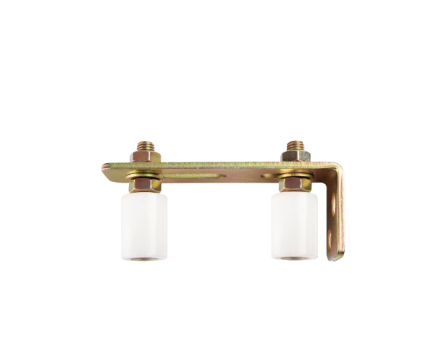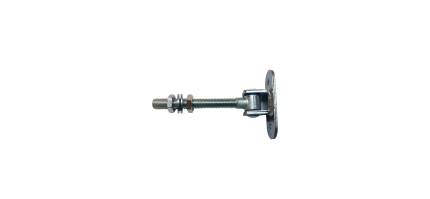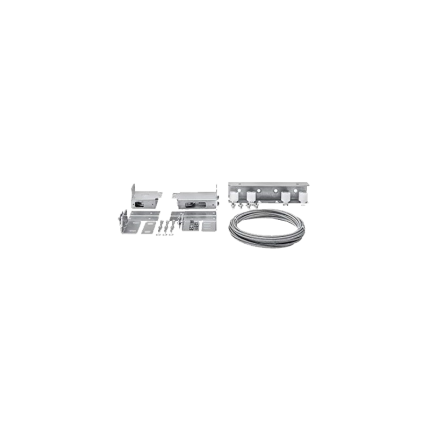Gate Hardware
Support Roller
Ship or pick up from our office.
Support Roller
*Steel adjustable L-bracket included *6-1/4” Length x 2-5/8” Width (Heavy-duty bolts, nuts, 2 x rollers, and washers are included)Support Roller for sliding gates are essential components that ensure smooth, stable, and reliable gate operation.
They guide the gate along its track, preventing it from tipping or falling off and ensuring it opens and closes with minimal friction and noise.
Function:
-
Guidance:Support rollers are typically mounted on the gate posts and guide the gate along its track as it opens and closes.
-
Stability:They keep the gate upright and prevent it from swaying or falling out of alignment, especially in windy conditions or with heavier gates.
-
Smooth Operation:By minimizing friction, they allow the gate to slide easily and quietly, enhancing the user experience.
-
Durability:They are designed to withstand the wear and tear of regular use and exposure to the elements.
Types:
- Nylon Rollers: Often used due to their durability, smooth operation, and resistance to corrosion.
- Rubber Rollers: While cheaper, they may leave marks on the gate and wear out faster.
- V-Groove Wheels: Suitable for specific track types and known for their longevity.
Installation:
- Positioning: Support rollers are typically installed on the gate posts, positioned to guide the gate along its track.
- Spacing: A gap of 5-10mm is usually recommended between rollers to allow for some movement and prevent them from doing all the work, especially if the gate is not perfectly balanced.
- Fixation: They are usually secured with bolts or by welding them to the post.
Maintenance:
-
Lubrication:Applying a silicone-based lubricant to the support rollers and other moving parts can help maintain smooth operation and reduce noise.
-
Regular Inspection:Inspecting rollers for wear and tear or damage is recommended to ensure continued reliable performance.
Swing gate adjustable hinge
Ship or pick up from our office.
Swing gate adjustable hinge
*Steel material *Heavy-duty hinge *5-1/2” Length (Total 7-1/2”) x 4-1/2” Width *Bolt thickness: 3⁄4”Telescopic sliding gate hardware
Ship or pick up from our office.
Telescopic sliding gate hardware
Telescopic sliding gate hardware refers to the specialized components and kits used to construct and operate a telescopic sliding gate system. Unlike a traditional single-leaf sliding gate, a telescopic gate consists of multiple gate leaves (typically two or three) that slide and overlap each other as they open, significantly reducing the amount of "run-off" space required for the gate to retract. This makes them ideal for properties with limited lateral space. Here's a breakdown of the key hardware components and how they work: How a Telescopic Sliding Gate Works: The core principle behind a telescopic gate is the synchronized movement of its multiple leaves. This is typically achieved through a cable and pulley system or a geared track system.- Cable and Pulley System: This is a common method. When the primary gate leaf (the one directly driven by a motor or moved manually) begins to open, a series of cables and pulleys pull the secondary and tertiary leaves along parallel tracks. The cables are strategically routed so that each subsequent leaf moves at a faster rate, allowing them to stack neatly behind the primary leaf when fully open.
- Geared Track System: Some advanced systems use a geared track where a pinion on one gate leaf engages with a rack on the next, driving it along.
- Gate Leaves: These are the individual sections of the gate. They are designed to slide smoothly past each other.
- Tracks:
- Ground Tracks: Parallel tracks are installed on the ground for each gate leaf to slide on.
- Upper Guide Profile/Track: A top guide system is crucial for stability and smooth movement, preventing the gate leaves from wobbling or derailing.
- Wheels: Each gate leaf has wheels (often V-groove or round groove) that run along the ground tracks. These are typically heavy-duty to support the weight of the gate.
- Pulley System/Transmission Unit: This is the heart of the telescopic mechanism. It includes:
- Pulleys: Used to route and guide the steel cables.
- Steel Cables: Connect the gate leaves, ensuring synchronized movement.
- Cable Covers/Casings: Protect the cables and provide a neat appearance.
- Adjustable Pulley Systems/Tensioners: Allow for precise adjustment of cable tension to ensure smooth operation and prevent stretching over time.
- Connection Brackets/Couplers: Connect the cables to the gate leaves.
- Guide Brackets/Rollers: These are installed at the top of the gate or on a support post to keep the gate leaves aligned and stable as they move. They often feature nylon rollers to reduce friction and noise.
- Gate Stops and Receivers: To define the fully open and closed positions and secure the gate when closed.
- Gear Rack (for automated gates): If the gate is automated, a gear rack will be installed on the primary gate leaf, which engages with a pinion on the gate motor.
- Gate Motor (for automated systems): A powerful sliding gate motor is required, often a low-voltage DC motor with advanced electronics to handle the varying speeds and loads of the multiple leaves. A speed reduction gearbox may also be incorporated for safety.
- Space-Saving: The primary advantage, as they require significantly less run-off space than single-leaf sliding gates.
- Wider Opening: Allows for a wider clear opening in situations where space limitations would otherwise restrict it.
- Faster Operation: Can often open and close more quickly than a single, very large sliding gate.
- Aesthetics: Can be a more visually appealing solution for properties with limited space.
- Complexity: More complex to design and install than a standard sliding gate due to the synchronized movement.
- Maintenance: Requires regular lubrication and checking of the cable and pulley system to ensure smooth and reliable operation.
- Weight Distribution: Proper engineering is crucial to distribute the weight of multiple gate leaves evenly and ensure stability.












